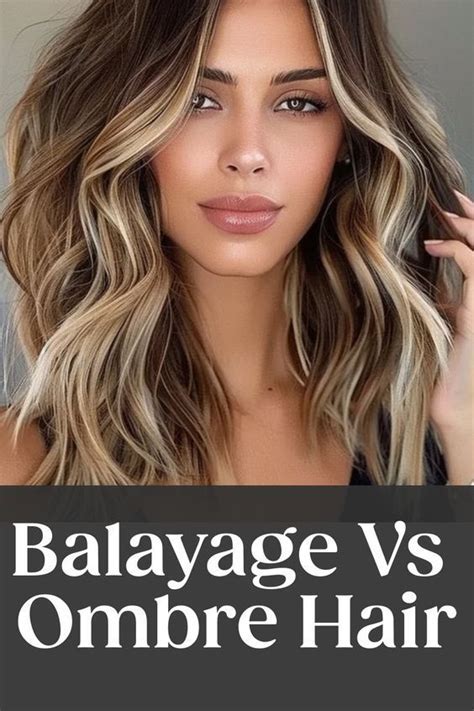Traditional Highlights

Traditional highlights involve bleaching small sections of hair to create a contrasting effect against the natural base color. They are applied strategically throughout the head, resulting in a more noticeable and defined look.
Balayage
Balayage is a French hair-painting technique where bleach or color is hand-painted onto the hair’s surface, creating a more natural and blended result. The hair is typically lifted several shades lighter, mimicking the effect of sun-kissed highlights.
1. Placement and Application
- Highlights: Applied in foils or caps, which isolate sections of hair for precise bleaching.
- Balayage: Freehand painting allows for a more artistic and fluid application, creating a softer, blended effect.
2. Level of Contrast
- Highlights: Typically create a higher level of contrast between highlighted and non-highlighted areas.
- Balayage: Results in a more subtle and blended look, with less defined demarcation lines.
3. Maintenance
- Highlights: Require regular touch-ups (every 6-8 weeks) to maintain color and blend in regrowth.
- Balayage: Requires less frequent touch-ups (every 12-18 weeks) as the blended effect helps conceal regrowth.
4. Damage
- Highlights: Can cause more damage to hair due to the use of foils and chemical processing.
- Balayage: Less damaging as it only targets the surface of the hair, minimizing breakage and preserving hair health.
5. Versatility
- Highlights: Can be customized to create various looks, from chunky to fine and subtle.
- Balayage: Ideal for creating natural-looking, sun-kissed hair, but less versatile for bold or patterned designs.
6. Cost
- Highlights: Generally more expensive due to the time and effort required.
- Balayage: Often less expensive, as it is a more efficient technique.
7. Time Required
- Highlights: Can take several hours to apply, depending on the number of sections and the desired level of contrast.
- Balayage: Typically takes less time to apply, as the painting process is more streamlined.
Consider Your Hair Type:
- Balayage is best suited for fine to medium hair textures, while highlights can work well for all hair types.
Face Shape and Skin Tone:
- Highlights can enhance facial features and create a lifting effect, while balayage adds warmth and dimension to the face.
Lifestyle and Maintenance:
- Balayage requires less maintenance and is ideal for busy individuals or those seeking a more natural look.
- Highlights require more regular touch-ups, but allow for more dramatic color transformations.
Budget:
- Consider the cost of the initial service and ongoing maintenance when making a decision.
| Feature | Highlights | Balayage |
|---|---|---|
| Level of Contrast | High | Subtle |
| Placement | Isolated sections | Freehand application |
| Maintenance | Regular touch-ups | Less frequent touch-ups |
| Damage | Higher | Lower |
| Versatility | Customizable | Natural-looking |
| Cost | More expensive | Less expensive |
| Time Required | Longer | Shorter |
| Hair Type | Highlights | Balayage |
|---|---|---|
| Fine | Yes | Yes |
| Medium | Yes | Yes |
| Thick | Yes | Yes (but may require more sections) |
| Coarse | Yes (may require multiple sessions) | Not recommended |
| Face Shape | Highlights | Balayage |
|---|---|---|
| Oval | Enhances features | Adds warmth |
| Round | Frames face | Elongates face |
| Square | Softens angles | Adds dimension |
| Heart | Accentuates cheekbones | Balances features |
| Service | Price Range |
|---|---|
| Highlights (full head) | $150-$300 |
| Highlights (partial) | $100-$200 |
| Balayage (full head) | $120-$250 |
| Balayage (partial) | $80-$180 |
- Consult with a professional hairstylist to determine the best technique for your hair type and desired look.
- Consider your lifestyle, maintenance preferences, and budget when making a decision.
- Experiment with different shades and tones to create a personalized and flattering result.
Q1: Can I get both highlights and balayage at the same time?
A1: Yes, combining highlights and balayage can create a customized look with both contrast and blended effects.
Q2: Which technique is better for hiding gray hair?
A2: Highlights can be more effective for concealing gray hair as they provide more coverage and definition.
Q3: How often should I wash my hair after getting highlights or balayage?
A3: Limit hair washing to 2-3 times per week to avoid stripping color and preserve the vibrancy of your highlights or balayage.
Q4: Can I use purple shampoo with highlights or balayage?
A4: Purple shampoo can be beneficial for maintaining the color of both highlights and balayage, as it counteracts unwanted yellow or brassy tones.
Q5: What should I look for in a hairstylist for highlights or balayage?
A5: Look for an experienced and certified hairstylist who specializes in color techniques and has a portfolio showcasing their work.
Q6: How can I extend the longevity of my highlights or balayage?
A6: Use color-protecting shampoos and conditioners, avoid excessive heat styling, and protect your hair from the sun with a UV spray.
Q7: Can I get highlights or balayage on dark hair?
A7: Yes, but darker hair may require multiple sessions and a stronger bleaching agent to achieve the desired level of lift.
Q8: Which technique is better for a low-maintenance look?
A8: Balayage is generally considered a lower-maintenance option as it requires less frequent touch-ups and blends more seamlessly with regrowth.
